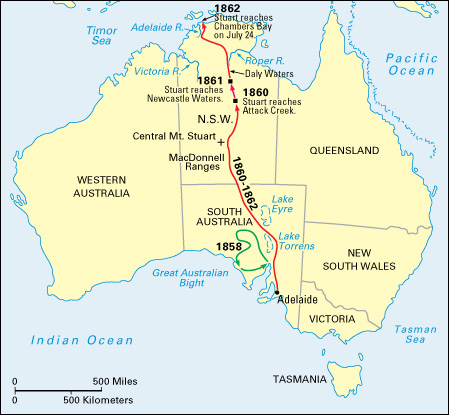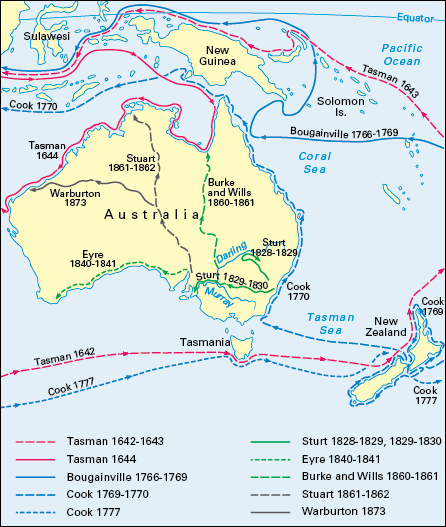Stuart, John McDouall (1815-1866), a Scottish-born explorer, made several expeditions into the Australian interior and crossed the continent from south to north in 1862. As a result of Stuart’s expedition from the south to the north of the continent, the British colony of South Australia gained control of the Northern Territory in 1863. Later, the Overland Telegraph was built along the route that Stuart had followed.

Stuart was born in Dysart (now part of Kirkcaldy ), Scotland , on Sept. 7, 1815. He attended the Scottish Naval and Military Academy in Edinburgh . In 1838, he left the United Kingdom for Australia and arrived in Adelaide , South Australia, in 1839. He soon began working as a land surveyor. (A surveyor is a person who uses special knowledge and tools to accurately measure and describe land.)
Stuart’s chief ambition was to explore new country. In 1844, he joined an exploring party led by the explorer Charles Sturt and traveled north from the Murray-Darling river junction to Eyre Creek. In 1858, Stuart led a small expedition to explore the country to the west of Lake Torrens and Lake Eyre in east-central South Australia. In 1859, he traveled northward to within 100 miles (160 kilometers) of the northern boundary of South Australia. He made two other journeys into the interior, in 1859 and 1860.
On Jan. 1, 1861, Stuart and a party of 11 men left Chambers Creek in eastern South Australia in an attempt to cross the continent. Stuart was a professional explorer, and he hoped to win the reward of 2,000 British pounds offered by the South Australian government to the first person who accomplished this feat. Stuart reached an area in the Northern Territory that he called Sturt Plains (later known as Sturt Plain) after his colleague Charles Sturt. However, Stuart failed to find a route north to the Victoria River. This delay substantially reduced provisions, and the exhausted party returned to Adelaide.
In October 1861, Stuart made a second attempt to reach the north coast of Australia from Adelaide, this time with a group of nine other men. Stuart and his party traveled through the center of the continent and continued northward. Extreme heat greatly hindered the expedition, and the unexpected deaths of a number of horses forced the party to abandon many of their provisions. At Sturt Plains, thick scrub tore the expedition’s water bags and greatly slowed progress. Nevertheless, on July 24, 1862, the party reached the Indian Ocean near the site of the present-day city of Darwin.

The return trip was one of extreme difficulty and deprivation. Provisions were low. Stuart, ill with scurvy —a disease caused by a lack of vitamin C—and infected eyes, had to be carried on a stretcher for much of the journey. The expedition eventually reached the city of Adelaide on Dec. 17, 1862.
Stuart won the reward of 2,000 British pounds from the government of South Australia for crossing the continent. In 1864, he sailed to Scotland to visit his sister. Later that year, his book Explorations in Australia was published. He died in London on June 5, 1866.
